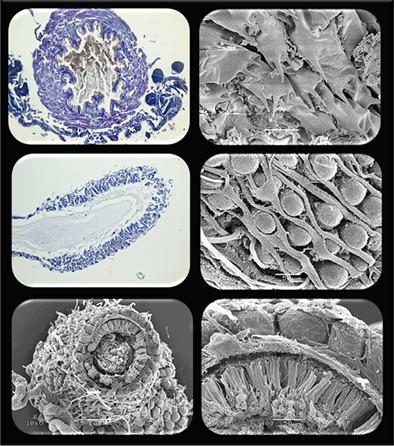当前位置:
X-MOL 学术
›
Microsc. Res. Tech.
›
论文详情
Our official English website, www.x-mol.net, welcomes your feedback! (Note: you will need to create a separate account there.)
Characterization of the alimentary canal and Malpighian tubules of Chrysolina herbacea (Duftschmid, 1825) (Coleoptera: Chrysomelidae): Anatomical and histological approaches
Microscopy Research and Technique ( IF 2.5 ) Pub Date : 2020-12-11 , DOI: 10.1002/jemt.23671 Nurcan Özyurt Koçakoğlu 1 , Selami Candan
Microscopy Research and Technique ( IF 2.5 ) Pub Date : 2020-12-11 , DOI: 10.1002/jemt.23671 Nurcan Özyurt Koçakoğlu 1 , Selami Candan
Affiliation

|
The mint beetle or green mint beetle, Chrysolina herbacea, is one of the most important insect pests of mint herb. These insects are associated with plants belonging to the Lamiaceae family, in particular the Mentha genus. They cause serious damages to plants by consuming their leaves. For this reason, it is an important agricultural pest, and the structure of the digestive system must be known well to combat these insects. The alimentary canal of adult C. herbacea divided into three main regions: foregut, midgut and hindgut. The foregut is characterized by the following parts; pharynx, esophagus, crop, and proventriculus. The proximal part of Malpighian tubules joins with the pyloric valve. Their distal parts are located in the hemocoel and have a wavy appearance and a flat surface. Malpighian tubules are surrounded by a single layer of cubic epithelium which is with brush border, and sheath. The hindgut is formed the following regions; pyloric valve, ileum, colon and rectum. In foregut and hindgut, the layers represented from within out are: intima, epithelium, muscle layer. In the midgut, the layers from within out are: peritrophic membrane, epithelium, muscle layer. The foregut has a monolayer cubic epithelium with oval nuclei. In the midgut, the epithelium is simple columnar while in the hindgut, the epithelium is simple cuboidal. This is the first report on alimentary canal and Malpighian tubules histo-anatomy in C. herbacea. The results will help guide the development of new strategies for managing this pest.
中文翻译:

Chrysolina herbacea (Duftschmid, 1825) (Coleoptera: Chrysomelidae) 的消化道和 Malpighian 小管的特征:解剖学和组织学方法
薄荷甲虫或绿薄荷甲虫,Chrysolina herbacea,是薄荷药草最重要的害虫之一。这些昆虫与属于唇形科植物,特别是薄荷属的植物有关。它们通过消耗植物的叶子对植物造成严重损害。因此,它是一种重要的农业害虫,必须充分了解消化系统的结构才能对抗这些昆虫。成人的消化道C. herbacea分为三个主要区域:前肠、中肠和后肠。前肠的特点如下:咽、食道、作物和胃。Malpighian 小管的近端部分与幽门瓣相连。它们的远端部分位于血腔内,外观呈波浪状,表面平坦。Malpighian小管被单层立方上皮包围,该上皮具有刷状缘和鞘。后肠形成以下区域;幽门瓣、回肠、结肠和直肠。在前肠和后肠中,由内而外代表的层是:内膜、上皮、肌肉层。在中肠,由内而外的层数是:周膜、上皮、肌肉层。前肠具有单层立方上皮和椭圆形细胞核。在中肠,上皮是简单的柱状,而在后肠,上皮是简单的立方体。这是关于消化道和马氏小管组织解剖学的第一份报告C. 草本植物。结果将有助于指导制定管理这种害虫的新策略。
更新日期:2020-12-11
中文翻译:

Chrysolina herbacea (Duftschmid, 1825) (Coleoptera: Chrysomelidae) 的消化道和 Malpighian 小管的特征:解剖学和组织学方法
薄荷甲虫或绿薄荷甲虫,Chrysolina herbacea,是薄荷药草最重要的害虫之一。这些昆虫与属于唇形科植物,特别是薄荷属的植物有关。它们通过消耗植物的叶子对植物造成严重损害。因此,它是一种重要的农业害虫,必须充分了解消化系统的结构才能对抗这些昆虫。成人的消化道C. herbacea分为三个主要区域:前肠、中肠和后肠。前肠的特点如下:咽、食道、作物和胃。Malpighian 小管的近端部分与幽门瓣相连。它们的远端部分位于血腔内,外观呈波浪状,表面平坦。Malpighian小管被单层立方上皮包围,该上皮具有刷状缘和鞘。后肠形成以下区域;幽门瓣、回肠、结肠和直肠。在前肠和后肠中,由内而外代表的层是:内膜、上皮、肌肉层。在中肠,由内而外的层数是:周膜、上皮、肌肉层。前肠具有单层立方上皮和椭圆形细胞核。在中肠,上皮是简单的柱状,而在后肠,上皮是简单的立方体。这是关于消化道和马氏小管组织解剖学的第一份报告C. 草本植物。结果将有助于指导制定管理这种害虫的新策略。



























 京公网安备 11010802027423号
京公网安备 11010802027423号